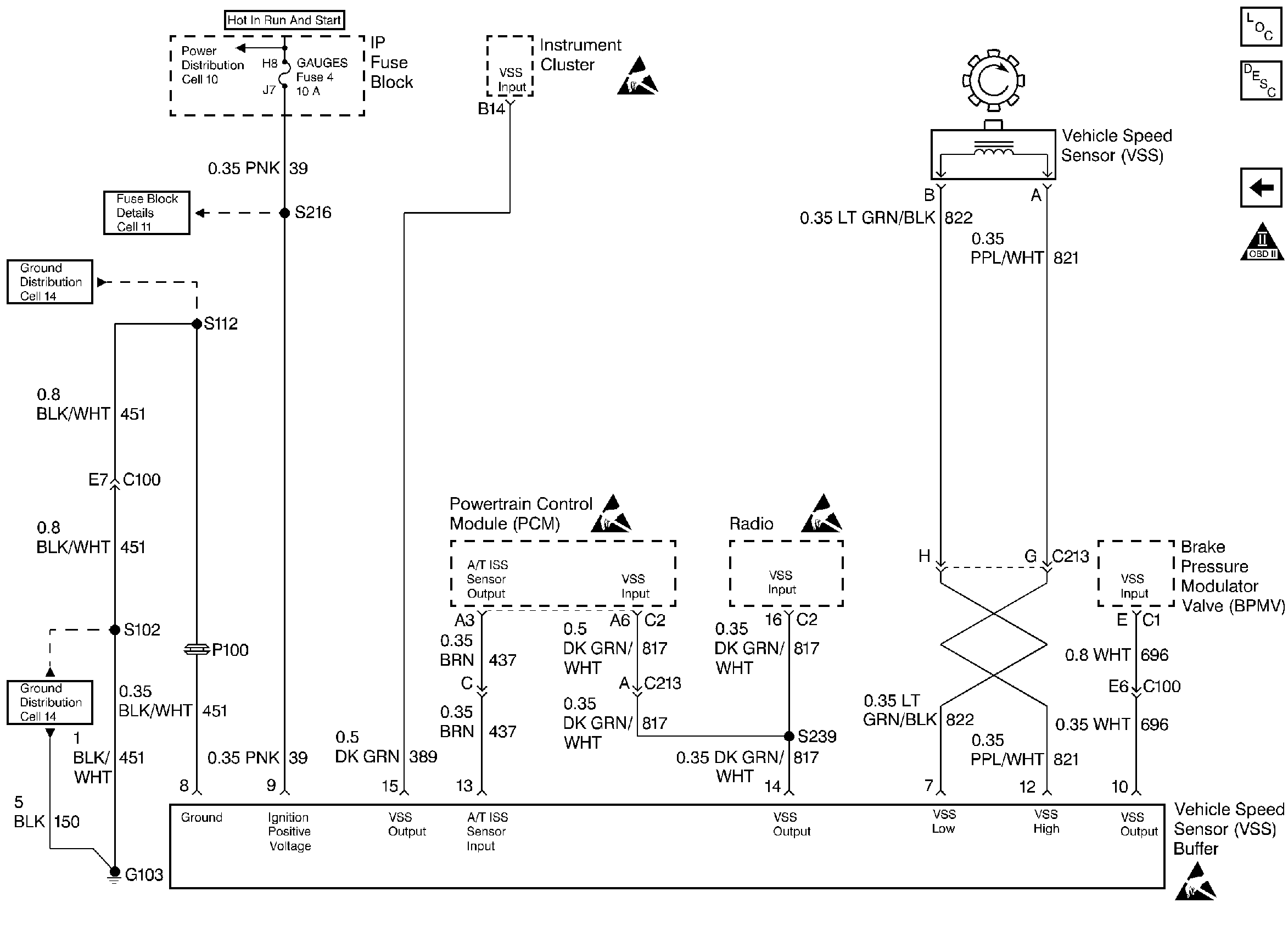DTC P0722 Output Speed Sensor Circuit Low Input Diesel Applications Only
Important: Refer to Automatic Transmission Controls Cell 39,
Vehicle Speed Sensor (VSS)

schematic, for the applicable
schematic.
Circuit Description
The speed sensor circuit consists of a magnetic induction type sensor, a Vehicle Speed Sensor (VSS) buffer module and wiring. Gear teeth pressed onto the output shaft induce an alternating voltage into the sensor. This signal transmits to the VSS buffer module. The VSS buffer module compensates for various final drive ratios. The VSS buffer module also converts the AC VSS signal into a 40 pulse per revolution (PPR) DC signal on circuit 437 to indicate transmission output speed.
When the PCM detects a low output speed when the vehicle has a high engine speed in a drive gear range, then DTC P0722 sets. DTC P0722 is a type A DTC.
Conditions for Setting the DTC
| • | No APP Sensor DTCs P0122, P0123, P0222, P0223, P0227, or P0228. |
| • | No TFP Val. Position Sw. DTC P1810. |
| • | The TP Sensor is greater than 12%. |
| • | The engine torque must be 100-565 N·m (80-450 lb ft). |
| • | The engine speed must be 2200-3800 RPM. |
| • | The ISS Sensor speed is greater than 2200 RPM. |
| • | The transmission is not in Park or Neutral. |
| • | The OSS sensor speed is less than 200 RPM for at least 3 seconds. |
Action Taken When the DTC Sets
| • | The PCM defaults to maximum line pressure. |
| • | The PCM freezes shift adapts. |
| • | The PCM defaults to the calculated output speed value using the Input Shaft Speed Sensor values. |
Conditions for Clearing the DTC
| • | The PCM turns OFF the MIL after three consecutive ignition cycles without a failure reported. |
| • | A scan tool can clear the DTC from the PCM history. The PCM clears the DTC from the PCM history if the vehicle completes 40 warm-up cycles without a failure reported. |
| • | The PCM cancels the DTC default actions when the fault no longer exists and the ignition is OFF long enough in order to power down the VCM. |
Diagnostic Aids
| • | Inspect the wiring for poor electrical connections at the PCM. Inspect the wiring for poor electrical connections at the transmission 20-way connector. Look for the following conditions: |
| - | A bent terminal |
| - | A backed out terminal |
| - | A damaged terminal |
| - | Poor terminal tension |
| - | A chafed wire |
| - | A broken wire inside the insulation |
| • | When diagnosing for an intermittent short or open condition, massage the wiring harness while watching the test equipment for a change. |
Test Description
The numbers below refer to the step numbers on the diagnostic table.
-
This step verifies the fault condition.
-
This step tests the voltage supply to the VSS buffer module.
-
This step tests the integrity of the ground circuit.
Step | Action | Value(s) | Yes | No | ||||
|---|---|---|---|---|---|---|---|---|
1 | Was the Powertrain On-Board Diagnostic (OBD) System Check performed? | -- | ||||||
Important: Before clearing the DTCs, use the scan tool in order to record the Freeze Frame and Failure Records for reference. The Clear Info function will erase the data. Does the Trans OSS increase with the drive wheel speed? | +200 RPM | Problem is intermittent. Go to Diagnostic Aids | ||||||
3 |
Does the voltage read within specifications? | Greater than 7 volts at greater than 10 mph. | ||||||
Is the voltage within the specified range? | Greater than 7 volts and greater than 7 mph. | |||||||
5 |
Did you find and correct a problem? | -- | Go to Diagnostic Aids | |||||
6 |
Is ignition voltage present? | -- | ||||||
Did the test lamp light? | -- | |||||||
8 |
Does the voltage increase with the drive wheel speed? | -- | ||||||
9 | Inspect circuit 389 for continuity. Refer to Section 8. Did you find a problem? | -- | ||||||
10 | Replace the OSS Sensor. Refer to 4L80-E On-Vehicle Service. Is the replacement complete? | -- | -- | |||||
11 | Repair circuit 821 and circuit 822. Refer to Repair Procedures, Section 8. Did you correct the problem? | -- | -- | |||||
12 | Repair the open or short in circuit 39. Is the repair complete? | -- | -- | |||||
13 | Repair the open or short in circuit 451. Did you find and correct a problem? | -- | -- | |||||
14 | Replace the Signal Buffer Module. Is the replacement complete? | -- | -- | |||||
15 | Repair the open or short in circuit 389. Is the repair complete? | -- | -- | |||||
16 | Replace the PCM. Refer to Powertrain Control Module Replacement/Programming , Section 6. Is the replacement complete? | -- | -- | |||||
17 | In order to verify your repair, perform the following procedure:
Has the test run and passed? | -- | System OK |
